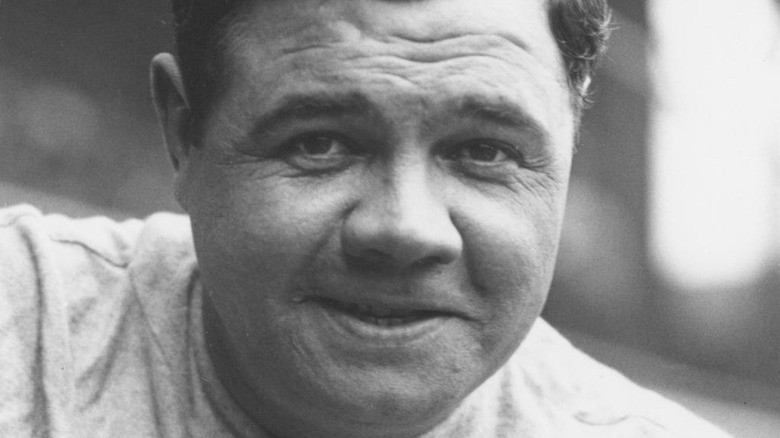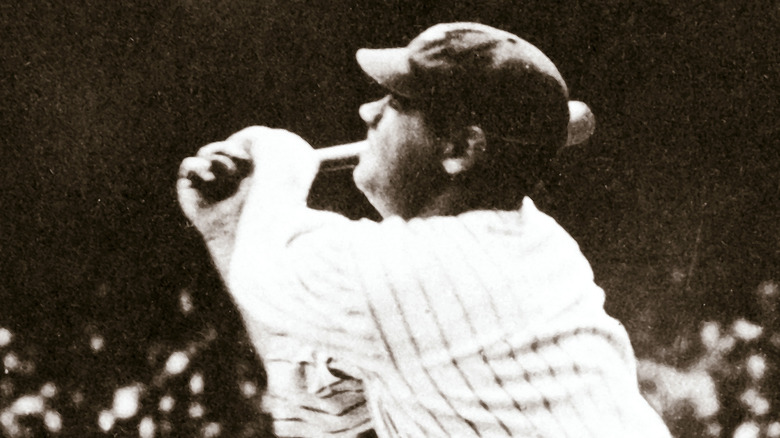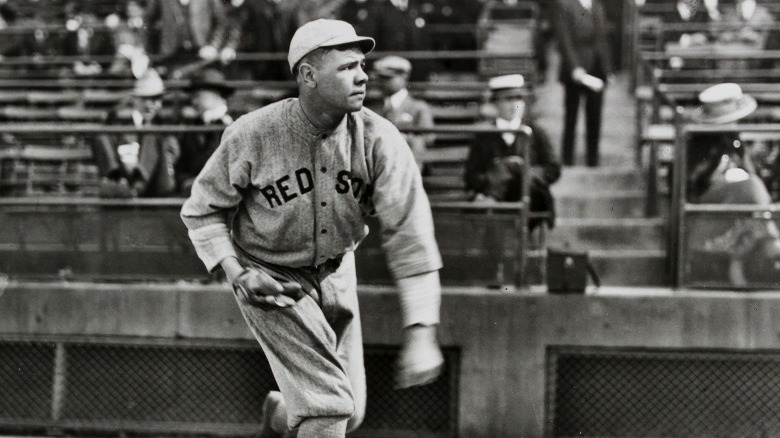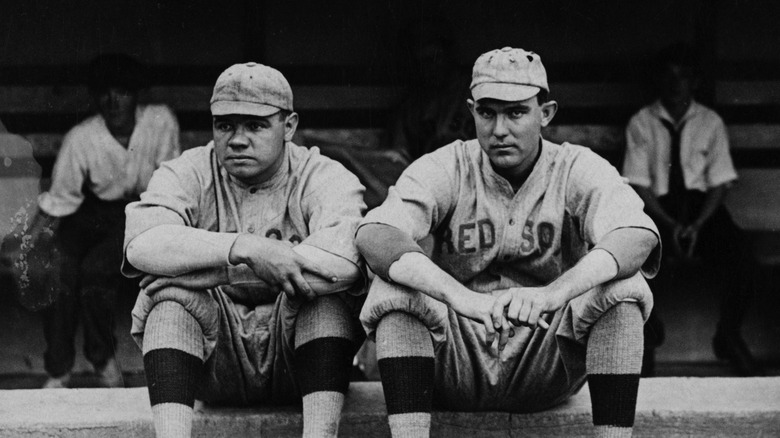Babe Ruth Once Punched An Umpire In The Middle Of A No-Hitter
Despite a relative increase in frequency —sparking debate over whether or not that's good for baseball, according to The Ringer — no-hitters are still a rarity. According to Baseball Almanac, there have only been 316 recorded no-hitters, with the first one coming in 1876 when George Bradley tossed one for the St. Louis Brown Stockings in a game against the Hartford Dark Blues (via Society for American Baseball Research).
Even more rare than a no-hitter is a combined no-hitter which happens when a team uses two or more pitchers to accomplish the feat. There have only been 17 of these in Major League Baseball history. After all, why would most managers want to phone the dugout if his starting pitcher is on such a roll that he's working toward a no-no? Well, in recent years, teams have been more aware of pitchers hitting high pitch counts and removing them from the game to minimize injury risks (via Sports Fan Focus). This is what led to a 2022 combined no-hitter for the New York Mets when starter Tyler Megill was pulled after hitting a career-high 159 pitches in just five innings. He and four other pitchers managed to secure the no-hitter for the Mets over the division rival Philadelphia Phillies.
Of course, there are other ways to get removed from a game and still achieve a combined no-hitter. Injury, fatigue, or — in the case of baseball's greatest legend, Babe Ruth — punching an umpire.
The early days of the Bambino
George Herman Ruth Jr. is now remembered by a few nicknames, including the Bambino and the Sultan of Swat, but he's best known as Babe Ruth. Ruth grew up in Baltimore, according to Britannica, where his parents operated a saloon. Ruth grew up in a tough neighborhood and seemed to be destined for a life of crime and poverty, but he found baseball in his teens and quickly caught the attention of the minor league incarnation of the Baltimore Orioles in 1914. The next year, the Babe was on to the majors after signing a deal with the Boston Red Sox.
Pitching left-handed, Ruth quickly asserted himself as the best in the league and during his tenure with the Sox — which lasted from 1915 to 1919, when he was famously dealt to the rival New York Yankees — Ruth amassed 87 games while posting an ERA of just 2.16. He also set a World Series record when he pitched a jaw-dropping 29⅔ consecutive shutout innings.
Given his incredible career including his years spent with the Red Sox, Ruth had many memorable games and individual moments that helped craft his legend. One of these occasions was during a game on June 23, 1917, when Ruth and the Sox faced off against the Washington Senators.
Babe Ruth's early exit
According to Baseball Reference, Ruth got the nod to start that day and took the hill at the top of the first inning, ready to face the Washington Senators' second basemen, Ray Morgan. According to a Boston Globe account of the game, Ruth threw four balls to Morgan, handing the leadoff hitter a quick walk. Pitchers and umpires being unable to find common ground with respect to the strike zone dates back to the era of Abner Doubleday. Ruth was sure that at least two of those balls had been strikes, and he let umpire Brick Owens know.
Ruth chirped at Owens to "Open your eyes and keep them open," to which the umpire replied with a threat to eject the Bambino. Ruth then shot back, "You run me out and I will come in and bust you on the nose," which led Owens to give him the boot. Ruth, a man of his word, ran toward Owens. Red Sox catcher Pinch Thomas tried to keep the 6'2", 215-pound Ruth from getting to the umpire, but he couldn't contain him. The Sultan of Swat first threw a left, which missed, but his next shot with his right ended and caught Owens square in the left ear. It took Red Sox manager Jack Barry and several police officers to subdue Ruth and get him off the field.
Ernie Shore steals the show
When Babe Ruth was playing for the Red Sox, Fenway Park wasn't yet the historic, hallowed ground it is today. It was in fact a relatively new ballpark, built in 1912 (via Britannica). While tales of what happened at Fenway Park in June 1917 are usually headlined by Ruth, the truth of the matter is he was a bit player in a stellar pitching performance by Red Sox right-hander Ernie Shore (via Baseball Reference).
Once everything had settled down after Ruth's outburst, there was a baseball game to play. Jack Berry tapped Shore to take the Bambino's place on the mound, where he faced his first batter, Washington third basemen Eddie Foster. According to Baseball Reference, Shore recorded just two strikeouts, which meant that he had to rely on his and his teammates fielding ability to prevent any Senators from getting a hit. The Boston Globe writes that Shore himself had to field several bunt attempts en route to a 4-0 Sox win. According to the MLB, some regarded this as a perfect game for Shore, but technically, since Ray Morgan had gotten on base via a Babe Ruth Walk, it's recorded as a combined no-hitter, even though Shore himself had a perfect game.
Coincidentally, years later, with both pitchers members of the New York Yankees, Ruth went into the stands to confront a heckler, who then pulled a knife on him. Shore has been credited by some as being responsible for breaking up the fight, though Ruth claimed it was Yankees owner Til Huston who did it (via Society for American Baseball Research).



